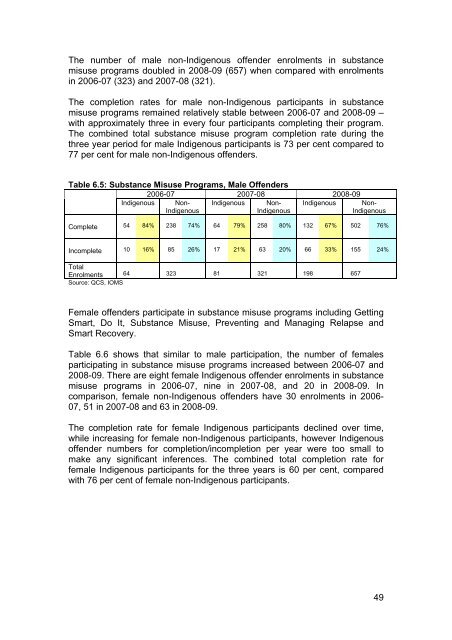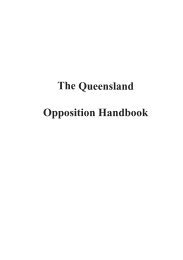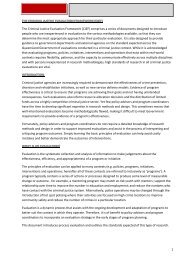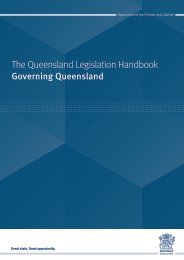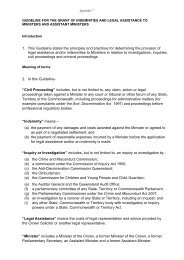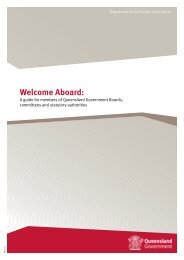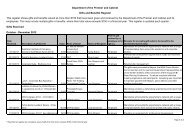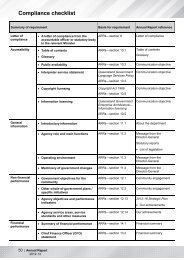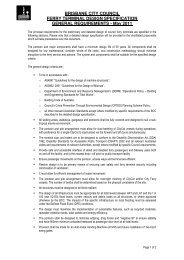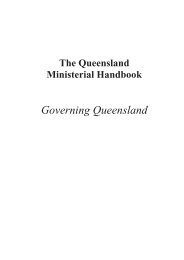Rehabilitative needs and treatment of Indigenous offenders in ...
Rehabilitative needs and treatment of Indigenous offenders in ...
Rehabilitative needs and treatment of Indigenous offenders in ...
You also want an ePaper? Increase the reach of your titles
YUMPU automatically turns print PDFs into web optimized ePapers that Google loves.
The number <strong>of</strong> male non-<strong>Indigenous</strong> <strong>of</strong>fender enrolments <strong>in</strong> substancemisuse programs doubled <strong>in</strong> 2008-09 (657) when compared with enrolments<strong>in</strong> 2006-07 (323) <strong>and</strong> 2007-08 (321).The completion rates for male non-<strong>Indigenous</strong> participants <strong>in</strong> substancemisuse programs rema<strong>in</strong>ed relatively stable between 2006-07 <strong>and</strong> 2008-09 –with approximately three <strong>in</strong> every four participants complet<strong>in</strong>g their program.The comb<strong>in</strong>ed total substance misuse program completion rate dur<strong>in</strong>g thethree year period for male <strong>Indigenous</strong> participants is 73 per cent compared to77 per cent for male non-<strong>Indigenous</strong> <strong>of</strong>fenders.Table 6.5: Substance Misuse Programs, Male Offenders2006-07 2007-08 2008-09<strong>Indigenous</strong> Non-<strong>Indigenous</strong><strong>Indigenous</strong> Non-<strong>Indigenous</strong><strong>Indigenous</strong> Non-<strong>Indigenous</strong>Complete 54 84% 238 74% 64 79% 258 80% 132 67% 502 76%Incomplete 10 16% 85 26% 17 21% 63 20% 66 33% 155 24%TotalEnrolments 64 323 81 321 198 657Source: QCS, IOMSFemale <strong>of</strong>fenders participate <strong>in</strong> substance misuse programs <strong>in</strong>clud<strong>in</strong>g Gett<strong>in</strong>gSmart, Do It, Substance Misuse, Prevent<strong>in</strong>g <strong>and</strong> Manag<strong>in</strong>g Relapse <strong>and</strong>Smart Recovery.Table 6.6 shows that similar to male participation, the number <strong>of</strong> femalesparticipat<strong>in</strong>g <strong>in</strong> substance misuse programs <strong>in</strong>creased between 2006-07 <strong>and</strong>2008-09. There are eight female <strong>Indigenous</strong> <strong>of</strong>fender enrolments <strong>in</strong> substancemisuse programs <strong>in</strong> 2006-07, n<strong>in</strong>e <strong>in</strong> 2007-08, <strong>and</strong> 20 <strong>in</strong> 2008-09. Incomparison, female non-<strong>Indigenous</strong> <strong>of</strong>fenders have 30 enrolments <strong>in</strong> 2006-07, 51 <strong>in</strong> 2007-08 <strong>and</strong> 63 <strong>in</strong> 2008-09.The completion rate for female <strong>Indigenous</strong> participants decl<strong>in</strong>ed over time,while <strong>in</strong>creas<strong>in</strong>g for female non-<strong>Indigenous</strong> participants, however <strong>Indigenous</strong><strong>of</strong>fender numbers for completion/<strong>in</strong>completion per year were too small tomake any significant <strong>in</strong>ferences. The comb<strong>in</strong>ed total completion rate forfemale <strong>Indigenous</strong> participants for the three years is 60 per cent, comparedwith 76 per cent <strong>of</strong> female non-<strong>Indigenous</strong> participants.49


